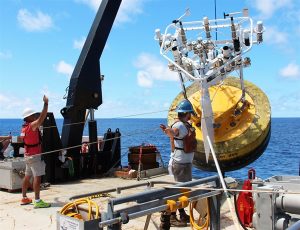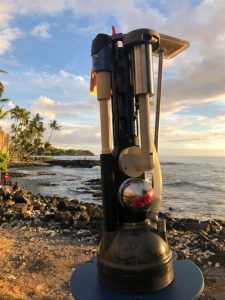Adrift NTAS Buoy Successfully Recovered
 On October 20, 2020, after a 450 mile drift lasting over 5 months, the Northwest Tropical Atlantic Station Mooring (NTAS, located at 15°N, 51°W, 5055 meter water depth) buoy and all of its subsurface instrumentation were successfully recovered. The Woods Hole Oceanographic Institution (WHOI) science team was able to prepare the replacement buoy on short notice, and it was deployed during the same cruise to re-establish NTAS. It was a significant effort, both ashore and at sea, and many thanks are owed to those involved. The NTAS buoy was first discovered to be adrift on April 28, 2020. It was most recently deployed in January 2020, just prior to the NOAA’s Atlantic Tradewind Ocean-Atmosphere Mesoscale Interaction Campaign (ATOMIC) field campaign. The buoy was drifting in the EEZ of Barbados.
On October 20, 2020, after a 450 mile drift lasting over 5 months, the Northwest Tropical Atlantic Station Mooring (NTAS, located at 15°N, 51°W, 5055 meter water depth) buoy and all of its subsurface instrumentation were successfully recovered. The Woods Hole Oceanographic Institution (WHOI) science team was able to prepare the replacement buoy on short notice, and it was deployed during the same cruise to re-establish NTAS. It was a significant effort, both ashore and at sea, and many thanks are owed to those involved. The NTAS buoy was first discovered to be adrift on April 28, 2020. It was most recently deployed in January 2020, just prior to the NOAA’s Atlantic Tradewind Ocean-Atmosphere Mesoscale Interaction Campaign (ATOMIC) field campaign. The buoy was drifting in the EEZ of Barbados.
After pursuing several avenues for a NTAS rescue mission, GOMO was able to secure the NOAA ship Ronald H. Brown for both a mooring recovery and deployment in October – the first cruise the ship would have in the current COVID-19 environment. After originally sheltering-in-place in Norfolk, VA, the original mission departure site, the ship sailed without the team aboard to carry out training and other tasks. The WHOI science team moved to Charleston, SC to shelter-in-place again and await the ship’s arrival. This allowed the WHOI team and ship crew more time in quarantine to satisfy the WHOI and NOAA COVID-19 safety protocols. On October 14, 2020, the WHOI science team was picked up by a small launch, brought onboard NOAA ship Ronald H. Brown and commenced the NTAS operation. They were be the only non-NOAA crew aboard. By October 20, 2020 the mooring and subsurface instrumentation were reported successfully recovered.
The NTAS mooring has been maintained at its location since March 2001 collecting high-quality time series of surface meteorology and upper ocean temperatures, velocities and salinities. The valuable data collected has improved our understanding of air-sea fluxes and sea-surface temperatures in the Northwest Tropical Atlantic. Further delay in recovery of the NTAS mooring could lead to increased risk of the buoy and subsurface instrumentation grounding, creating a hazard to shipping, and/or loss of more than $0.5M in sensors and mooring equipment.
